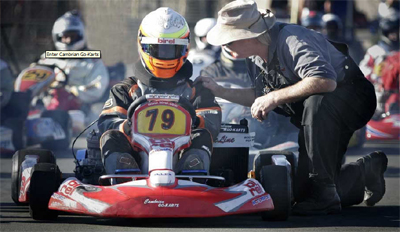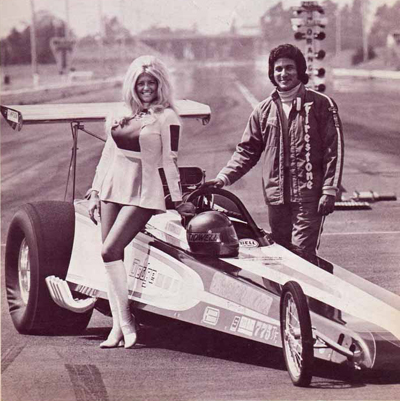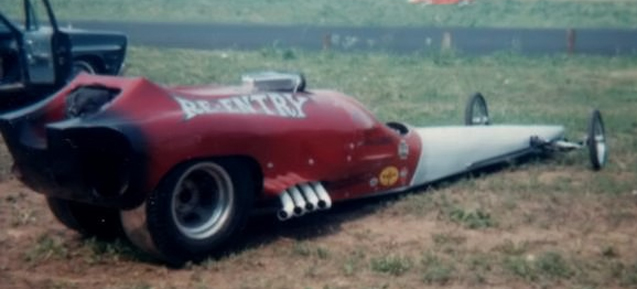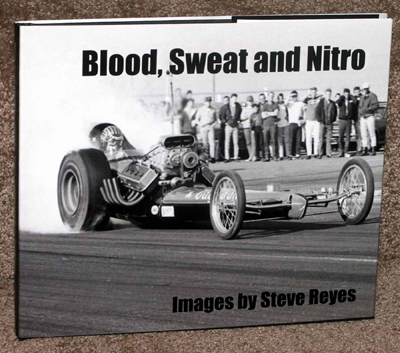

One more thing before I go ...
Surprise, it's me! Yeah, I know I told you last week not to expect anything from me for the next week due to travel and a heavy National DRAGSTER workload, but you know me … a glutton for punishment. I got all of my stuff done and am uploading this column as I'm preparing to dash out the door to the airport at o'dark thirty Wednesday morning.
A couple of interesting things have cropped up that I wanted to share, plus I knew you guys would be having wedge withdrawals if I stayed away too long. It's hard to believe that we've been talking almost exclusively about the same subject since March 19, when I brought it up only in reference to acknowledging the passing of NHRA Safety Safari member Ron Rickman, famous for being the guy in Connie Kalitta's bull's-eye when he stacked up "Poncho" Rendon's wedge at Indy in 1971. So, here we go …
 |
 |
From the "I-know-it's-not-really-a-wedge-but" file comes these photos from Gary Osborn of Don Durbin's Favorite Thing Top Fueler. If you thought front-wheel pants were all the rage in the 1970s, how about these babies? In 1977, Durbin's dragster featured rear-wheel pants, and, though they didn’t catch on, they certainly did raise eyebrows. (To be fair, I already had discussed this via e-mail with reader Joe Gorman, who first sent me pics, but that was before the anything-goes wedge discussion took off.)
I never really spent any time with Durbin in the short while our NHRA careers crossed paths, but he was easy enough to find online, so I called him to ask about the design, and, after a little wait, he got back to me to discuss the "fenders," as he calls them.
The fenders actually had a bit of a space-age genesis. Durbin, an electrician by trade, was working at NASA's Ames Research facility in Mountain View, Calif., and met a man there who was interested in cars and helped Durbin design them. Jack Hagemann Jr., whose dad used to build sports-car and dragster bodies, built the fenders for Durbin out of hand-formed aluminum. The fenders were built with enough room for the tires to grow, and the insides were covered with rubber padding to prevent damage from any stones that the tires might kick up.
"The fella from Ames was pleased with the way they looked, and I never experienced any trouble with them," said Durbin, who still has the fenders. "Gary Beck told me, 'Durbin, you keep beating the bushes, and if it works, we'll try it.'
"The best I ever ran with them was a 6.0 at 249 mph when I should have been running 5.70s, but that probably had as much to do with being underfunded as anything," he admitted. "I'm not complaining; that's just the way it was. I never had the latest and greatest stuff -- I was still running a 392 then; I was probably one of the last guys to run one – and if I had the same kind of power as others I might have been able to make a better comparison. I do think they would have made a difference. They seemed to do what they were supposed to do."
 |
Durbin retired from racing after the 1986 season and as an electrician in 2002 and today owns a popular go-kart shop in San Jose, Calif., Cambrian Go-Karts, which he opened with his son, Donald, in November 2004.
"I was just getting used to the idea of being retired when my son, who had been go-kart racing for some time, told me the most fun he ever had was helping people with go-karts and parts, so I told him we could start a place of our own." That's Durbin at right with his son.
"Sorry it took so long to get back to you," he apologized. "I was over at Half Moon Bay watching the ocean and making sure it didn't get away." Ah, the life of leisure.

On another wedge-related note, I heard again from Jim Rossi, son of Vince Rossi, co-owner of a wedge with Tommy Lisa; without knowing it, he had answered a question that was kind of ruminating in the back of my mind. The handout that Robert Flitsch had sent of the car claimed the wedge as the "1st car to run 5-second E.T." Well, we all know that the late Mike Snively owns the official mantle as first in the fives and that Tommy Ivo was credited with a disputed early five-second time slip, but the Lisa & Rossi car?
 |
Turns out that the team had gone to Lions Drag Strip one Wednesday during one of the track's doorslammer nights to do test runs, trying to dial in the clutch. "The car launches and makes a picture-perfect blast," he remembered. "The time light flashes a 5.99 e.t., and the announcer goes crazy. It was the first five-second run ever in a Top Fueler. As fast as the announcer blurted that out, the mike went dead for what seemed like an eternity. All of a sudden, the announcer comes back on with a 'We're sorry, folks, but obviously that was an incorrect read, and we apologize for the error.' Well my father and Tommy ran up to the tower and saw for their own eyes the 5.99 e.t. still lit up on the clock and started to ask Steve Evans what was up. Steve came up with some story that it had to be wrong -- the sun must have been setting on the beams, triggering the error in reading -- and he was not going to allow the read to be logged in as official. You could imagine the disappointment Vince and Tommy felt when Steve disallowed the run. One thing is for certain: This car was the unofficial first car in the fives, make no mistake about it."
Above is yet another shot of the car, taken from the cover of the 1972 Nitro Championships race at Orange County Int’l Raceway, showing driver Billy Tidwell with the then Mrs. Billy Tidwell, the lovely Linda Vaughn.

After casting a line out into the Insider Ocean of Knowledge about the Re-Entry dragster's apparent mishap in Indy, mentioned Friday, several people told me that the car had flipped that year in Indy.
Florida-based drag racing encyclopedia Jim Hill wrote, "I seem to remember it was involved in a slow rollover, just past the finish line, just about where the Ford Tower is located. It was a very slick-looking car, great paint, etc., but it was considerably ahead of its time."
 |
Dennis Friend, proprietor of the popular Twins To Go website (http://twotogo.homestead.com/), sent the photo above of the car taken at Rockford Dragway shortly after Indy. The front end is primered, and the back end shows repair patches. The mystery deepens.

Hill also took note of what I thought was a clever appellation for the upcoming (and much more wordy) Summit Racing Equipment NHRA Southern Nationals as the "Big Go South," telling me that my clever wordsmithing is a tad tardy. "Fact is, it was used as the event name for a series of winter meets held in South Florida in the '60s. Big Go South was coined by South Florida Timing Association promoter and former NHRA Division 1 Director Ernie Schorb and used for several big winter drag events held in the Miami area on old World War II airport temporary track sites.
"Ernie, who played a key part in producing and operating the co-op NHRA-NASCAR Winter Nationals (Flagler Beach, Fla., February 1960), decided to leave 'Winter Nationals' alone as an event title, as [Wally Parks] used it for his first Pomona winter event in 1961. Instead, he used Big Go South and also Big Go East to title those races."

 |
I don't usually promote books here – if I did, I'd probably have a flood of requests, but I'm going to make an exception for Steve Reyes as gratitude for the many, many photos that he has contributed to this column.
Reyes has just completed a self-published hardcover book entitled Blood, Sweat and Nitro. "There are about 150 photographs in it, 98 percent of which haven't been seen for about 40 years," he told me. "Black and white photos of front-engined Top Fuelers, and a few Top Gas and Jr. Fuelers also."
The book will be a limited release with only 250 copies available for sale at $55 plus $5 shipping. All will be signed and numbered by Reyes and distributed on a first-come, first-served basis on receipt of payment. Orders for the book may be made by submitting payment of $60 per book in the form of a money order to Bethany Reyes, 150 NW 42nd St., Ocala, FL 34475. Payments via PayPal may be made to blrenterprise@cox.net.
Oh yeah, he said, one more thing: Here's another wedge to research. He shot this unknown wedge Top Fueler at OCIR in 1973. There's no lettering or even a permanent number to start the search. Damn you, Reyes. All right, who's gonna be first?
 |
OK, now I'm off to Atlanta. I'd tell you not to expect to hear from me again for about a week, but I might be lying. Again. See ya down the road.



















































